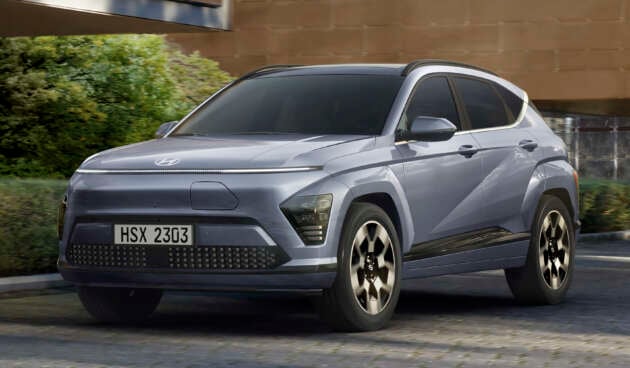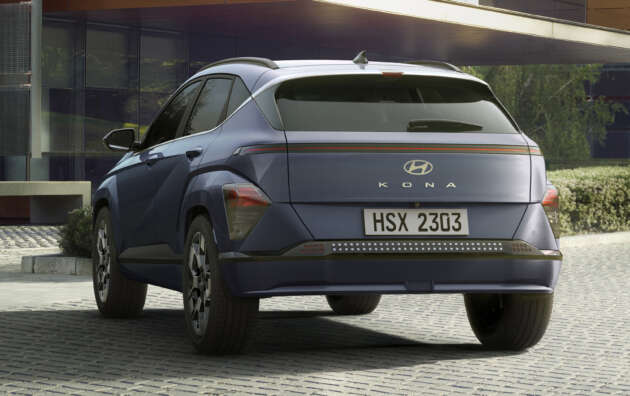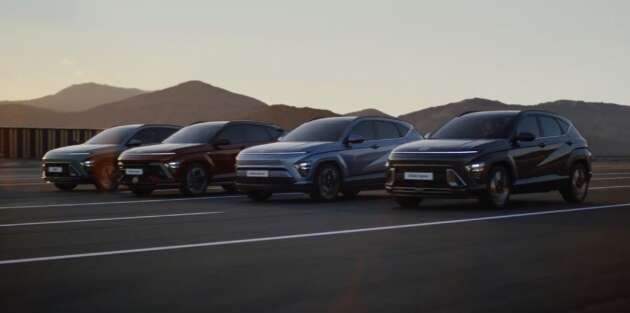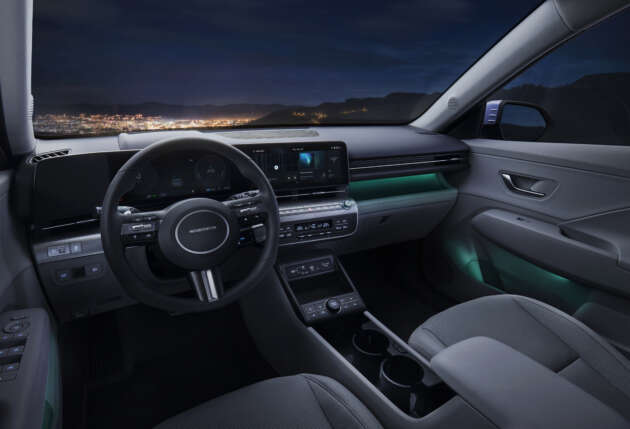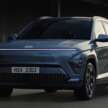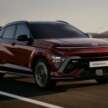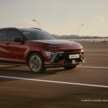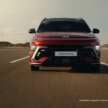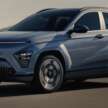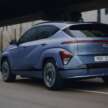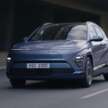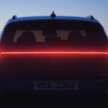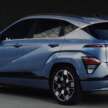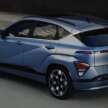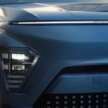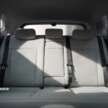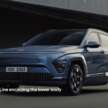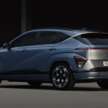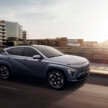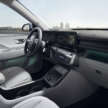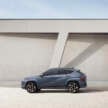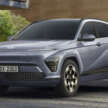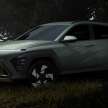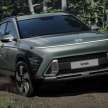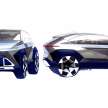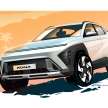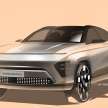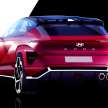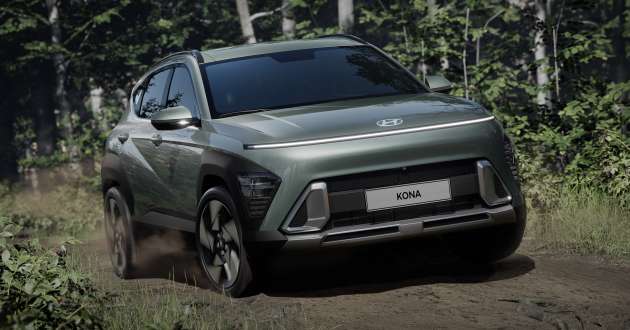After revealing the second-generation Hyundai Kona last December, the Korean carmaker is now providing more details of its redesigned B-SUV. As reported previously, the new Kona was developed as an electric vehicle (EV) first, so the main focus of the latest announcement is on the Kona Electric.
However, it should be noted that the SUV will also be offered in internal combustion engine (ICE), hybrid electric vehicle (HEV) and N Line versions. Information about these non-EV variants will be provided later.
The Kona Electric will be offered with two battery capacities – 48.4 kWh (Standard Range) and 65.4 kWh (Long Range) – both powering a front-mounted electric motor. With the Standard Range, the electric motor is rated at 156 PS (154 hp or 114.6 kW) and 255 Nm of torque, while the Long Range has a higher power output of 218 PS (215 hp or 160 kW) and the same amount of torque.
As for range, the smaller battery provides up to 342 km of range following the WLTP standard, with the Long Range offering as much as 490 km on a single charge. These figures are improvements over the previous Kona Electric that provided 305 km with a 39.2-kWh battery or 484 km with a 64-kWh unit (figures following our local specifications).
Hyundai did not provide detailed charging information but confirmed the Kona Electric has a 400-volt electrical architecture, allowing for DC fast charging – 10-80% state of charge is accomplished in 41 minutes. The Kona Electric also has vehicle-to-load (V2L) support, with different max outputs depending on the market it is sold in – 3.13 kVA (Europe), 1.63 kVA (North America) and 3 kVA (South Korea).
In terms of dimensions, the latest Kona is larger when compared to its predecessor, measuring in at 4,355 mm long (+175 mm), 1,825 mm wide (+25 mm), 1,575 mm tall (+20 mm) and with a wheelbase spanning 2,660 mm (+60 mm). The sporty N Line maintains the same figures, but its length is increased by a further 30 mm to 4,385 mm thanks to its more aggressive styling.
With an increased footprint, Hyundai says the Kona features a roomier interior for better passenger comfort. Front and rear headroom have been increased to 1,015 mm (+9 mm) and 972 mm (+12 mm) respectively, while rear leg is at 925 mm (+31 mm). The company also quotes 466 litres of boot space based on the VDA standard or 723 litres following the SAE with the fully foldable second-row seat and rear compartment.
On the exterior that has a drag coefficient of 0.27, we find a full-width light bar in the upper portion of the front end, which appears to be inspired by the Staria and Grandeur. The Kona Electric’s light bar has pixelated look to it (marketed as the Pixelated Seamless Horizon Lamp), which is a nod to the Seven concept and differentiates it from the non-EV variants.
This Parametric Pixels theme as Hyundai calls it, is specific to the Kona Electric and extends to the lower intake grille, rear bumper, 19-inch alloy wheels and wide taillights. Regular Kona models get black wheel arch cladding along with a rugged bumper and skid plate, with an exception being the N Line that gains a performance-minded look instead.
Inside, the cabin bears some semblance to the Ioniq 5 with its horizontal dashboard design featuring rectangular air vents and dual 12.3 inch displays. Unlike its EV sibling, the Kona has a centre stack linking the dash to the centre console which is festooned with physical controls for the media, climate and drive mode systems as well as power outlets. No gear lever in sight as a shift-by-wire system is used whereby putting the car into “gear” is done via a stalk behind the steering wheel.
Features that are available for the Kona include Digital Key 2 Touch which uses near-field communication (NFC) on smartphones or smartwatches to unlock the vehicle, an eight-speaker Bose sound system, the Bluelink streaming service, one-pedal driving (i-Pedal), a 12-inch head-up display, over-the-air (OTA) software updates, electronic-Active Sound Design (e-ASD) and an Eco Package.
Hyundai also offers a wide range of driver assistance systems with its SmartSense suite, including Forward Collision-Avoidance Assist (FCA), Blind-spot View Monitor (BVM), Remote Smart Parking Assist (RSPA), Driver Status Monitor (DSM), Blind-Spot Collision-Avoidance Assist (BCA), Intelligent Speed Limit Assist (ISLA), Driver Attention Warning (DAW), High Beam Assist (HBA), Parking Collision-Avoidance Assist (PCA), Surround View Monitor (SVM) and Rear Cross-Traffic Collision-Avoidance Assist (RCCA).
There are also a few SAE Level 2 semi-autonomous driving features like Lane Keeping Assist (LKA), Lane Following Assist (LFA), Highway Driving Assist (HDA) as well as Navigation-based Smart Cruise Control (NSCC).
Finally, Hyundai says the Kona will be offered in a wide range of colours, namely Abyss Black Pearl, Atlas White, Serenity White Pearl, Shimmering Silver Metallic, Cyber Gray Metallic, Ecotronic Gray Pearl, Ecotronic Gray Matte, Engine Red, Ultimate Red Metallic, Soultronic Orange Pearl, Jupiter Orange Metallic, Neoteric Yellow, Mirage Green, Amazon Gray Metallic, Cypress Green Pearl, Meta Blue Pearl, Denim Blue Pearl, Denim Blue Matte and Sailing Blue Pearl.
Depending on the variant, there are also quite a few interior themes to choose from too, including Black Mono, Grey Two-tone, Black and Sage Green, Black and Beige, Black and Red point (N Line only) as well as Dark Gray Mono (Eco pack only).

